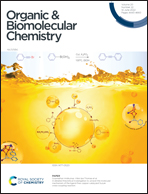Conformationally rigid, π-extended annulated porphyrinoids derived from the naphthobipyrrole motif†
Abstract
π-Extension in porphyrinoids can be achieved by fusing additional aromatic rings onto the macrocycle's periphery and such porphyrinoids are referred to as annulated porphyrinoids. Annulated porphyrinoids display contrasting properties in comparison with their non-annulated congeners. While an annulation strategy can create π-extended systems, the simultaneous incorporation of conformational rigidity in such porphyrinoids can ensure that they adopt a planar structure, and the advantages associated with the extended π-network can be leveraged. Hence, while synthesizing such porphyrinoids, judicial selection of the precursor becomes important. The ease of synthesis and the presence of a β–β′-linked o-phenylene bridge qualify 3,8–1,10-dihydrobenzo[e]pyrrolo[3,2-g]indole, commonly known as naphthobipyrrole, to be one such precursor suitable for the synthesis of conformationally rigid annulated porphyrinoids. This field of study has started to bloom only in the last decade and the examples reported so far are confined to the naphtho-versions of porphycenes (isomeric porphyrin), a few members of the aromatic/antiaromatic expanded porphyrinoids, and calix[n]bipyrroles. In view of this, the current review article aims to summarize the up-to-date developments in this area and discusses the synthesis, structure, and properties of the reported naphthobipyrrole-derived annulated porphyrinoids.



 Please wait while we load your content...
Please wait while we load your content...